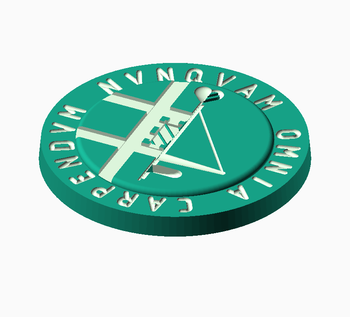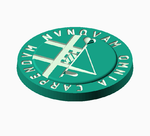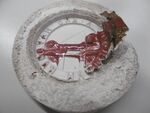PersonalSeal
| Project Personal Seal | |
|---|---|

| |
| Personal seal that could be medieval | |
| Status | Initializing |
| Contact | Molenaar |
| Last Update | 2019-12-17 |
I wanted a personal seal that would be historically correct in the Middle Ages. I already had one, but after I made it, it turned out to have a few properties that were not period-correct. It had the emblem lying on top of it, instead of being taken away. Also, it had no text. This was to show that, as a medieval craftsman, I could not read or write. However, the sealmaker definitely could, so any seal would have text, unless you wanted to pay so little that text was not affordable.
I want a good seal with text, as most seals in those days were. I admit that most craftsmen would not have a seal, but apart from that I want it to be as historically correct as possible. The text on the edge of the seal would be either a motto, or the name and/or title of the bearer. So city seals, for example, would have the name of the city.

The emblem of the seal is in two halves: one half is a pump drill, drawn half to a centre line. The centre line is denoted with a half-hatched heart, which was the pre-war method of drawing a "heart line". The other half is a mill wheel. The mill wheel is drawn around a wooden axis, which is hatched.
The pump drill is the symbol of the wood- and bone worker in Archeon (my former profession), and the mill wheel is the symbol of the voluntary millers (which I am now). The heart in the line is the love for the technology. Drawing something half against a centre line is what a technical draftsman would do, and that is a one of my former professions also. The motto "NVNQVAM OMNIA CARPENDVM" means "never take everything".
I want to try a new casting technique for making the seal. My original seal was made by making a model in wax and then casting it in sand, but that leaves the sand texture in the model. I want to have a finer grained model now, so I want to try to do a combined ceramic shell and sand cast. The back side is still cast in sand, while the emblem side is cast in a mixture of plaster of Paris and sand. The model is a 3D printed seal, designed in LibreCAD and OpenSCAD, and molten out of the ceramic shell, because the plaster of Paris mixture is so brittle.
First try
In my first try, I wanted to take the PLA out of the mould as-is. The shape of the seal is designed to be removable. However, The brittle plaster of Paris did not withstand removal.
Second Try

I tried to remove the seal by melting the PLA out of the mould using the project oven. Not only did this smell bad, but the thin layer of PLA connected to the pool at the bottom was so strong that the mould could not be taken out of the bowl. On the positive side, the details were sharp and the plaster of Paris mixture did not crack.
In the next try, I will use a gas burner in the sparkshack and try to use chamotte powder instead of sand.